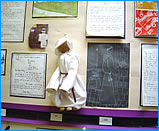 Focus on History
Focus on History
Standards in History
- In the schools visited, standards of achievement in history are good and often very good.
- Pupils in both Key Stages 1 and 2 have a good understanding of chronology. They sequence events and objects and construct time lines. They can associate photographs with particular periods and correctly match these on time lines.
- Pupils' knowledge and understanding about the past is often very good. Significant factors in this achievement include the very good subject knowledge of teachers, the excellent cross curricular work undertaken and the creative and imaginative projects developed by many schools. These include the use of Margam Park (Victorians), Theatre Nan Nog (Rebecca Riots), Chance Encounters Theatre Company (famous Welsh people), Titch Theatre, Kinetic Theatre Company, Welsh Brass Trio, Welsh Harpist, Artist in Residence (The Blitz), Story Sacks, anniversary concerts, websites and local history publications produced by schools.
- All schools visited, currently use the LEA scheme of work. Often this is supplemented with additional materials from other published schemes such as the QCA, ESIS, and LCP history resources files.
- Children make good progress in interpreting events from the past. They use a wide variety of artefacts and illustrations and make visits to museums and places of historical interest. Often artefacts such as Celtic roundhouses and jewellery are reproduced as part of cross curricular work and most schools use drama and role play in enabling children to interpret events from the past.
- Pupils enquiry skills are good and they access a comprehensive range of historical sources including using adults to talk to younger pupils about events in the past and about games played long ago. (Children then attempt to play the games themselves). In their studies of life in the 1950's pupils access films, television advertisements, pop music, newsreels and a wide range of written sources. Some schools use this information in productions of 50th Anniversary school celebrations.
- Pupils achieve good standards in organisational and communication skills. Drama and ICT are used very effectively in enabling children to communicate their knowledge and understanding of the past. Children re-enact scenes from history, ask historical questions and develop their knowledge and understanding through reading, writing, discussing, presenting, singing and by the use of ICT.
Standards of Achievement in the Key Skills
- Standards of achievement in key skills are good overall but few schools plan for the effective and progressive promotion of these skills across the curriculum. There is some confusion over what the key skills are which is compounded by different definitions from other agencies and uncertainty from various inspection teams.
- Pupils achieve good standards in oracy and in writing. Where a school has high numbers of pupils with SEN, priority is often given to developing speaking and listening skills through history. In the schools visited, children often read and evaluate a wide range of historical evidence. They have opportunities to formulate, discuss and interpret answers to historical questions. They are developing a good range of historical vocabulary.
- Pupils mathematical skills are further developed through the history curriculum when they study census returns and statistical data. Often this is done through a local study such as on Margam Park or the schools locality. They use graphs, maps and records accurately and develop their skills in comparing and contrasting data. In all the schools visited, children construct time lines such as using Teddy Bears (new and old), aspects of Tudor Wales, the Second World War and the 1950's. This enables children to understand time and distance when formulating views on different periods in the past.
- The use of ICT in the schools visited is a very good feature of the history curriculum. In the best practice, children construct electronic books; access the Internet for research, use videos, CD-ROMs, and simulations and a variety of historical databases. They take digital photographs and use these in 'PowerPoint' presentations on their local history projects. In one school, pupils use 'Textease Presenter' to import images and facts and make slides for presentations. This work is often cross-curricular and eventually designed for wider audiences as in school concerts, celebrations and publications.
| Continue: Quality of Learning |

